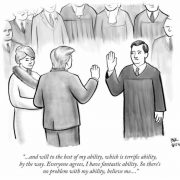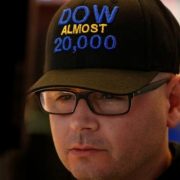“Alex, I’ll Take ‘Stock Market Trivia’ for $20,000.”
The Dow Jones Industrial Average, after many failed attempts, finally rallied above the 20,000 mark. While it seemed like a lengthy, arduous battle, the reality is that it only took 64 days from the time that the Dow first crossed 19,000 to the time it got to 20,000. In fact, this is the second shortest time between 1,000 point thresholds with the move from 10,000 to 11,000 taking only 35 days.
To be sure, it is easier to accomplish this with larger numbers as a 1,000 point move from 19,000 is 5.2% vs. 10% from 10,000. This makes the move from 10,000 to 11,000, a 10% jump in 35 days, that much more impressive. The real journey was that from 10,000 to 20,000 – it took almost 17 years as 10,000 was first hit in March 1999.
As some may recall, as the Dow got to 10,000 in 1999, the 20,000 mark was just around the corner on a trip to 36,000. At least that’s what some popular pundits were confidently predicting. Unfortunately, some stuff got in the way – the tech bubble, housing bubble, sub-prime crisis, great recession, etc. It’s a reminder that some roads can unexpectedly get rough. Before moving on, a trivia question on the Dow – prior to 20,000, what are the two 1,000 point thresholds that were only crossed once (obviously on the way up)? The answer later.
Dow 20,000 is an exciting milestone but when do we get to 21,000. From a momentum standpoint, stock prices have been moving from lower left to upper right since the election. Also, the breadth of advancing issues vs. declining issues has been good which points to a broad participation. Moreover, 67% of the S&P 500 are trading above their 50-day moving average which is a good sign. Finally, the number of new 52-week highs vs. the number of new 52-week lows has been a support for equities. This ratio expanded further last week as the Dow exceeded 20,000.
Valuation is another important metric. On this front, U.S. stocks are not cheap. The price-to-earnings ratios for the major averages are below. The earnings component is based on as reported earnings for the trailing twelve months.[i] The estimate is based on forecasted earnings for 2017.
Trailing Estimate
Dow Jones Industrial Average 21.11 17.50
S&P 500 24.74 17.52
Nasdaq Composite 20.10 19.15
While the numbers are not obscene, they are well above what is considered fair value which are levels in the mid-teens. The forward-looking P/E’s are reasonable but, of course, assume a larger denominator in the form of higher earnings. Part of that should be the result of a lower corporate tax rate and a stronger economy but neither is assured.
The P/E of the index provides an overall market valuation but breaking them down by sector gives a sense of where the opportunities and risks are.
Consumer Discretion 20.51 Consumer Staples 21.42
Energy 139.17 Financials 16.09
Healthcare 19.21 Industrials 19.48
Materials 20.03 Technology 22.92
Telecom 16.13 Utilities 17.15
These calculations are done by Bespoke Investment Group and are based on trailing twelve month earnings numbers.[i] On their face value, energy looks extremely overpriced but we would assume that the earnings number was dramatically reduced by write offs forced by the collapse in commodity prices. This P/E should come down in 2017 as oil prices have stabilized and the industry has cut expenses.
On the other hand, telecom and financials look undervalued. However, telecom might be facing growth obstacles while financials are dealing with heavy regulations. Both industry landscapes might improve under the Trump administration but the market appears to be waiting for the policy details.
Last week we got a first look at economic growth for 2016’s 4th quarter. GDP was reported as growing at 1.9% which was below the expected 2.2%. GDP is calculated by adding consumption, government spending, investments, and exports and then subtracting imports. Investment was much stronger in Q4 vs. Q3 and a big component of this was in mining, shafts, and oil and gas infrastructure.
This is a little misleading as there wasn’t a lot of investment in this area as it was only slightly positive. But this was the first quarter since Q4 of 2014 that this calculation was positive. As the energy industry adjusted to the fall in oil and gas prices, wells were shut down and capital investments were written off. The result was a negative number in the GDP formula from the energy industry throughout 2015 and the first 3 quarters of 2016.
Another noteworthy number from this report is that investment in industrial equipment is at an all-time high. Businesses are investing in equipment as this amount has exceeded the level reached before the financial crisis.
Inventories grew in the 4th quarter which reverses a trend of falling inventories levels for 6 straight quarters. Importantly there was no large drop in demand during this period of declining inventories. In other words, companies cut back on inventories as they anticipated slowing demand that never happened. Historically, this leads to a sharp recovery of inventories as businesses re-stock which is helpful to economic growth.
Another positive report from last week was the University of Michigan Consumer Sentiment report. This is a monthly release and its latest reading was 98.5 which is a multi-year high. Consumers are feeling upbeat about their situation and this should be supportive of stronger economic growth.
One conclusion in summarizing the above is that the economy is doing well but it has already been discounted in the capital markets. This data along with such things as the job market, productivity, and the housing market suggest a pretty good economy. Market valuations and dividend yields further suggest that stocks have already priced this in and are looking for a continuation of this growth.
Turning our focus from backward to forward, we are facing uncertainties. The Federal Reserve will be raising interest rates in 2017 which could be a headwind. Also, it could lead to a stronger dollar which slows exports and pressures the emerging markets. The global financial system is very much linked together so disruptions in other markets could make their way to our shores. This would be an unexpected problem.
As we know, there’s a new sheriff in town. This was clearly demonstrated in President Trump’s first week in office. One thing we can assume is that there will be some gigantic shifts that take place. They will impact the economy and there are going to be winners and losers.
Concerning the new president, the chart below is something to keep in mind.[ii] It shows the performance of the S&P 500 for the 60 days prior to a Republican inauguration day and the 60 days subsequent. As you can see, stocks after President Trump’s victory have outperformed prior GOP presidents. However, there is a clear decline in past examples and it begins around inauguration day. 2016 was a year to expect the unexpected so maybe this trend is broken with this Republican president.
 |
Returning to the beginning of this newsletter, the answer to the question of the two Dow 1,000 point thresholds that were only crossed once are 19,000 and 5,000. The 19,000 level could be easily crossed again as it’s only 5% away. Obviously, a normal 10% correction puts that level in play. Let’s hope that the 5,000 number is never in doubt.












